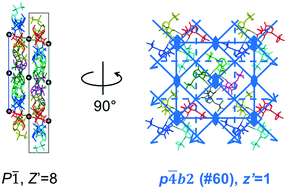Pseudosymmetric layers in high-Z′ and P1 structures of organic molecules†
Abstract
Layers having obvious approximate symmetry higher than that of the overall 3-D crystal are present in 20–25% of the Z′ > 4 and P1 organic structures archived in the Cambridge Structural Database (Groom et al., Acta Crystallogr., Sect. B: Struct. Sci., Cryst. Eng. Mater., 2016, 72, 171–179). Such layers were found in 72 of ca. 300 organic structures having more than four crystallographically independent formula units. In roughly a third of the 72 the approximate layer symmetry is broken by offsets perpendicular to the layer normal. In another third some of the independent layers are related by a local rotation, glide, or inversion operation. In the final third there are two or more layer types that differ in packing arrangement, pattern of strong interactions (e.g., H bonds), or even composition. If layers are related by simple offsets only, symmetry lowering could have taken place after crystal nucleation, perhaps as a consequence of cooling. If, however, alternating layers differ substantially in arrangement or orientation then the pattern would have had to be established at the time of nucleation. Layers of obvious approximate symmetry were also found in 136 members (22%) of a validated subset containing 615 (43%) of the 1422 (as of May 2019) organic, P1, 2 ≤ Z′ ≤ 4 structures having R ≤ 0.050. The layers in 129 of the 136 are related by a simple shift, which is the only possibility if Z′ = 2 or if the order of the approximate layer group is four. For those 129, a modulation during crystal growth or cooling probably lowered the symmetry of the original crystal nucleus.

- This article is part of the themed collections: Database Analysis and The Cambridge Structural Database - A wealth of knowledge gained from a million structures


 Please wait while we load your content...
Please wait while we load your content...